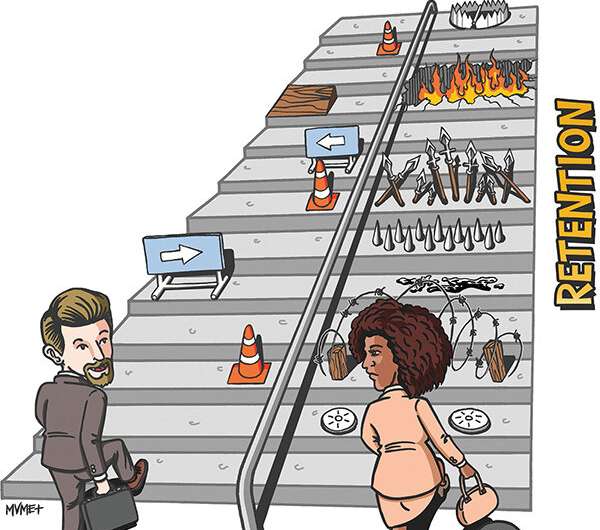Geoscience researchers call for updated metaphor to help make field more inclusive and equitable

As a Black woman in geosciences, especially a full professor who holds an endowed chair position, Asmeret Asefaw Berhe has jokingly called herself a unicorn.
"That's how rare it is," said Berhe, professor of soil biogeochemistry and Ted and Jan Falasco chair in earth science and geology in the Department of Life and Environmental Sciences at the University of California Merced. "There is no reason why in 2022 that should be the case."
The geosciences are among the least diverse STEM fields, with about 90% of doctorates going to white people and less than 4% of tenured faculty positions in geoscience departments being held by people of color.
To help combat this problem, a group of geoscience researchers is reimagining the "leaky pipeline" metaphor traditionally used to describe the lack of diversity and inclusion in the academy. The authors, including Berhe and University of Kansas researcher Blair Schneider, have written a paper in Nature Geoscience describing the "hostile obstacle course" that Black, Indigenous and other people of color face as they attempt to advance their careers.
"The leaky pipeline implies that the attrition of white women, BIPOC and members of other minoritized communities is a passive process: nothing more than a 'drip, drip' from holes within an otherwise robust system," the authors wrote. "In reality, we (and others) argue that the imagery of a leaky pipeline fails to represent the exclusionary experiences of many."
The paper, officially published Jan. 21, has already received 14,000 online views and more than 1,600 tweets. It currently ranks in the top 1% of most-viewed articles tracked by Altmetric.
The hostile obstacle course metaphor puts emphasis on systemic problems instead of individuals and better represents the experiences of marginalized geoscience scholars, the authors said. The obstacle course recognizes that barriers are not experienced equally.
"Our hope is that this reframing of the conversation puts the responsibility to address it rightfully with the leaders in our academic institutions, scientific leaders and senior folks who should take the responsibility to fix the current climate," Berhe said, "so that when we actually recruit students from whatever background it might be, they actually find a safe place—a home—in our academic institutions in science, and they don't experience isolation, microaggression, harassment and discrimination."
The authors presented an image to describe the metaphor and accompany the paper. It shows a white man and a Black woman preparing to ascend a staircase. The stairs represent career progression and retention in the field, with the top being career achievement. Each person faces obstacles on their climb, but the woman of color has far more and different kinds of barriers—racism, sexism, sexual harassment, gender harassment and more—to overcome.
Schneider, associate researcher and science outreach manager at KU's Kansas Geological Survey, is one of the paper's seven authors. Like Berhe, she is a co-principal investigator for the ADVANCEGeo Partnership, the group that wrote the paper and an effort funded by the National Science Foundation to address sexual harassment and other exclusionary behaviors that lead to hostile workplaces in the earth, space and environmental sciences.
"I really do appreciate the people who originally brought forth the leaky pipeline metaphor," Schneider said. "They were starting a dialog that hadn't happened yet. But let's update this to actually include this intersectionality component and the different barriers people face based on their identities."
Growing up, Schneider said she never knew pursuing a career as a scientist was an option for someone like her.
"None of that was promoted to me," she said. "I do feel like it was kind of luck along the way that I ended up where I am."
As a white woman, Schneider said that even though she has faced sexism and harassment in her field, her experiences can't compare to her colleagues of color.
"I haven't dealt with any racism," Schneider said. "I haven't feared for my life in certain situations like other colleagues and friends have, and so it's also very eye-opening. I don't think I would still be here if I had gone through that."
Moving forward, the group hopes this metaphor will reframe conversations and inspire new policies to recruit and retain people with diverse identities and lived experiences.
"Policies that you put in place for white women aren't necessarily going to help women of color," Schneider said. "Policies that you put in place to help women in general don't necessarily help those who have disabilities."
"It's important to me to make sure that the next generation of scholars who are coming behind me don't have to go through the same stuff," Berhe added. "There are plenty of people who are still starting to climb on that staircase, and I really want us to remove those obstacles because we have an obligation to provide everyone with a safe learning and work environment."How scientific leaders can enact anti-racist action in their labs
More information: Asmeret Asefaw Berhe et al, Scientists from historically excluded groups face a hostile obstacle course, Nature Geoscience (2021). DOI: 10.1038/s41561-021-00868-0
Journal information: Nature Geoscience
Provided by University of Kansas
No comments:
Post a Comment